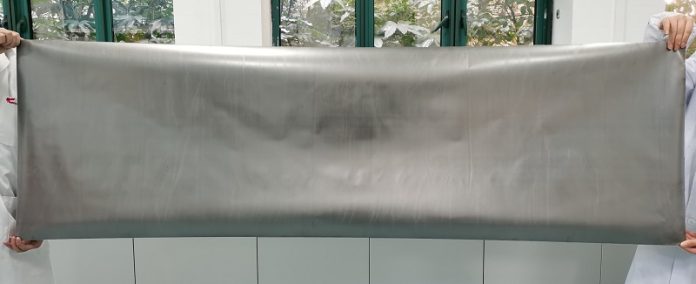
Researchers from Swansea University, in partnership with Wuhan University of Technology and Shenzhen University, have developed an exciting new technique for creating large-scale graphene materials.
This innovation could greatly improve the safety and performance of lithium-ion batteries (LIBs), which are used in many devices, including electric vehicles.
The study, published in Nature Chemical Engineering, describes the first successful method for producing high-quality graphene foils on a commercial scale.
These graphene foils are much better at conducting heat—up to 1,400.8 W m–1 K–1—than the traditional copper and aluminum materials currently used in LIBs.
This level of thermal conductivity is nearly ten times higher than what is typically seen with those materials.
“This is a major advancement for battery technology,” said Dr. Rui Tan from Swansea University, one of the study’s lead authors.
“Our method allows us to create graphene current collectors that can be easily integrated into commercial battery production.
This not only makes batteries safer by managing heat more effectively but also increases their energy density and lifespan.”
One of the biggest concerns with high-energy lithium-ion batteries, particularly in electric vehicles, is the risk of thermal runaway.
This is a dangerous situation where the battery generates too much heat, leading to potential fires or explosions.
The new graphene current collectors are designed to address this issue by efficiently dispersing heat and preventing the chemical reactions that cause thermal runaway.
“Our graphene structure is dense and well-aligned, which helps prevent the formation of flammable gases and stops oxygen from getting into the battery cells,” explained Dr. Jinlong Yang from Shenzhen University, another co-lead author of the study.
“This is crucial for avoiding catastrophic battery failures.”
What makes this new technique even more impressive is its scalability. The researchers have successfully produced graphene foils that are up to 200 meters long and just 17 micrometers thick.
These foils maintained their high electrical conductivity even after being bent over 100,000 times, making them ideal for use in flexible electronics and other advanced technologies.
The team’s approach also allows for the production of graphene foils with customizable thicknesses, which could lead to even safer and more efficient batteries in the future.
This breakthrough has the potential to impact the future of energy storage significantly, especially in areas like electric vehicles and renewable energy systems where safety and efficiency are key priorities.
The international research team, led by Professors Liqiang Mai and Daping He from Wuhan University of Technology, Dr. Jinlong Yang from Shenzhen University, and Dr. Rui Tan from Swansea University, is continuing to refine their process.
They are working on reducing the thickness of the graphene foils even further and improving their mechanical properties.
They are also exploring the use of this new material in other types of batteries, such as redox flow batteries and sodium-ion batteries, with help from Professor Serena Margodonna’s group at Swansea University.
This innovative graphene technology could be a game-changer, making batteries safer and more powerful than ever before.



